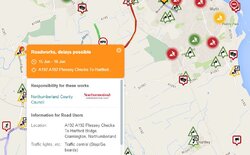Green will have a minimum time (7 seconds I think) which then gets extended if cars are still approaching the signal, up to maximum, which could theoretically be any time, but is likely to be no more than 60s, usually less, unless the road is heavily trafficked.
The Intergreen (time between green in one direction and green in the other) is at least 4s (iirc), and should allow just enough time for traffic in one direction to be clear before the other traffic stream moves. While they will use an appropriate speed for pedestrians on ped crossings I suspect most 'traffic' phases are timed for cars.
There are exceptions, as noted previously, but you'll be unsurprised to know that most people calculating signal timings are not thinking about cyclists.




 [/QUOTE]
[/QUOTE]